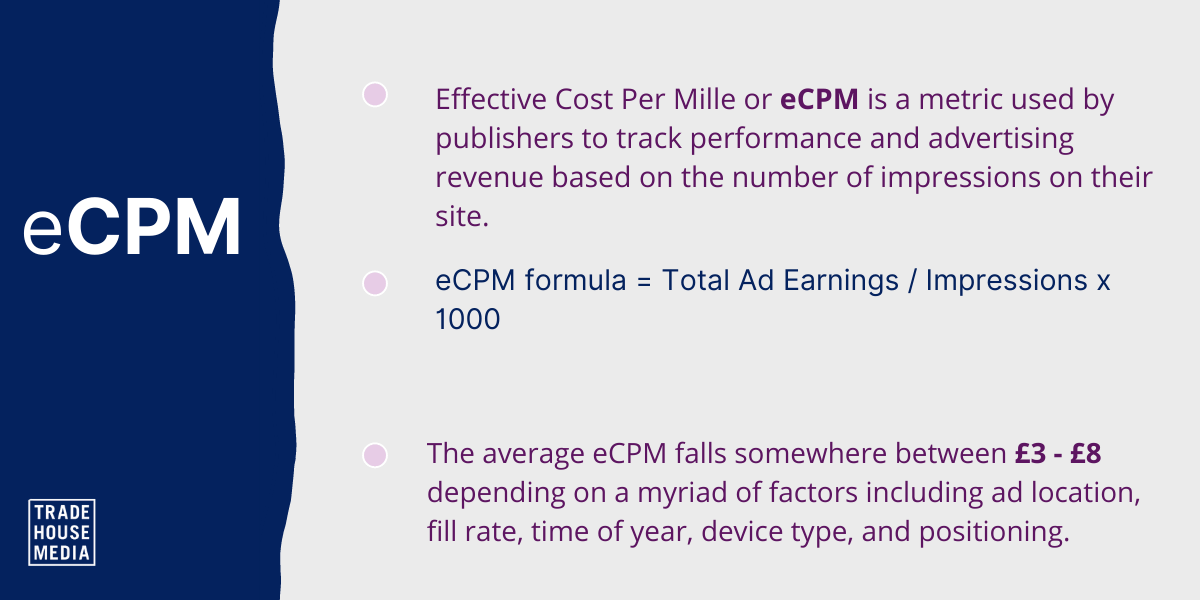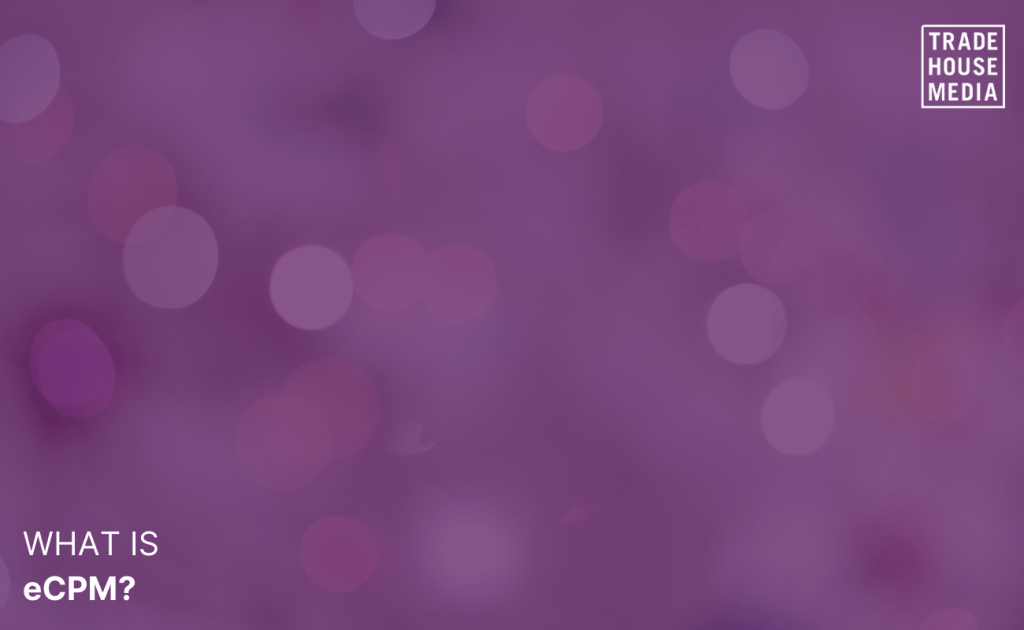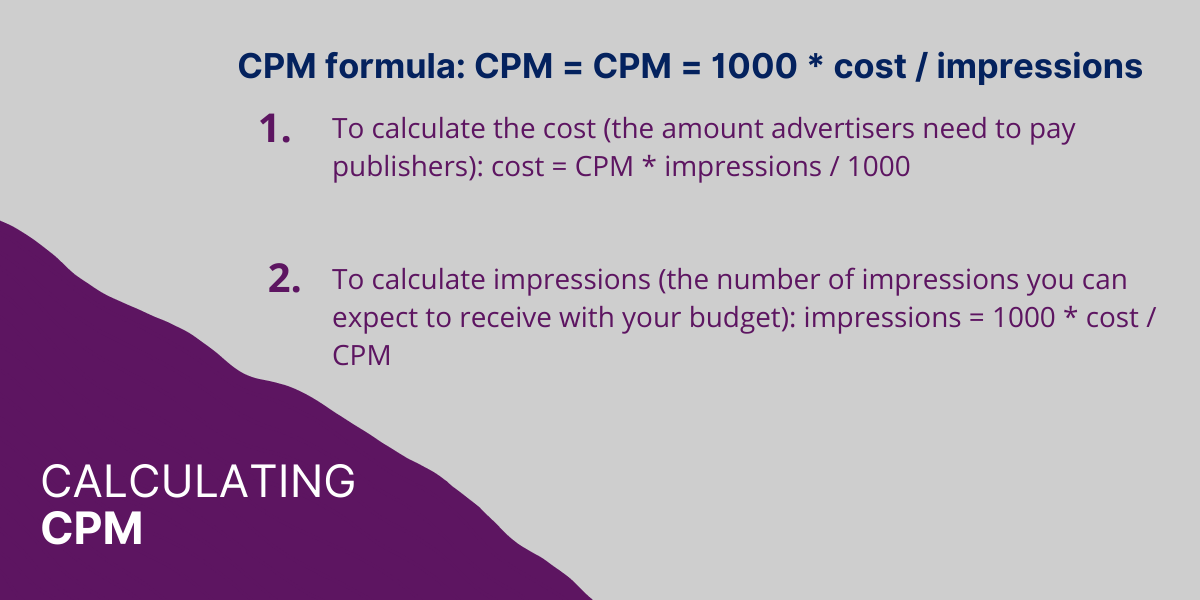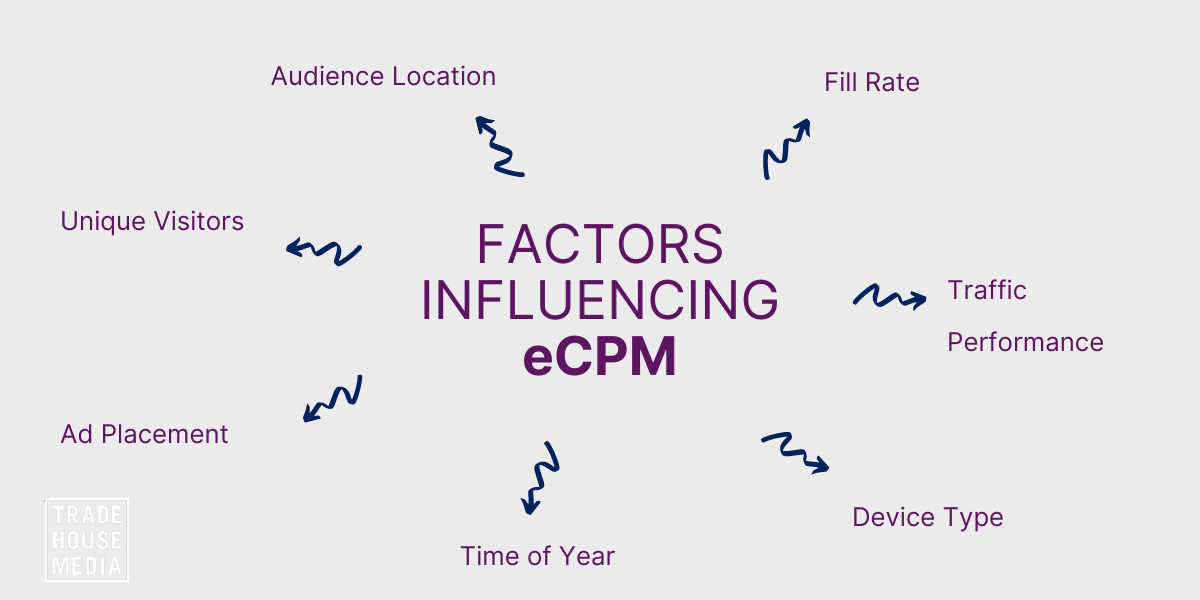Effective Cost Per Mille or eCPM is a metric used by publishers to track performance and advertising revenue based on the number of impressions on their site. eCPM allows publishers to effectively estimate future revenue using indicative benchmark figures and previous campaign performance.
eCPM is often (incorrectly) used interchangeably with CPM – another key metric used by advertisers and publishers. In this article, we will look at the important difference between CPM and eCPM, how to calculate these metrics, and how to optimise eCPM for improved advertising revenue performance.
CPM DEFINITION
Before we dive into eCPM, let’s start with some important housekeeping that will help to tie everything together.
CPM (cost per mille) is an advertising metric that is used by publishers and advertisers to measure the cost per thousand impressions in advertising. CPM refers to the price that advertisers must pay to publishers to put their content in front of users. In CPM campaigns, an impression occurs each time that an ad is displayed in front of a user on a website, app, or various other media platforms.
As an example, if a publisher sets their rate at £4.00 CPM, then an advertiser must pay a publisher £4.00 each time their ads are displayed in front of 1,000 users. Understanding CPM structure and pricing is essential for businesses and advertisers managing ad performance across different networks.
CPM advertising is a popular strategy for companies that are looking to build brand awareness and ‘penetrate’ into a new market. CPM campaigns are an effective way to get chins wagging and expose a new brand or product to a targeted audience.
How Can I Calculate CPM?
The formula for calculating CPM as just as simple as the concept behind it.
To calculate CPM, simply divide the cost by the number of impressions and then divide that number by one thousand.
CPM formula: CPM = 1000 * cost / impressions
To calculate the cost and the number of impressions that you can expect to receive, use the following two formulas:
- To calculate the cost (the amount advertisers need to pay publishers): cost = CPM * impressions / 1000
- To calculate impressions (the number of impressions you can expect to receive with your budget): impressions = 1000 * cost / CPM
ECPM DEFINITION
eCPM or Effective CPM is the revenue that a publisher earns per one thousand impressions. The higher the eCPM figure, the more money that publishers earn from their advertising inventory.
How Can I Calculate ECPM?
The eCPM formula is a simple, repeatable formula that can be used to measure ad monetisation performance based on the amount of revenue that is earned per 1,000 ad impressions. To calculate the eCPM, simply divide the total ad earnings by impressions and multiply it by 1000.
eCPM formula = Total Ad Earnings / Impressions x 1000
What Is the Average eCPM?
The average eCPM falls somewhere between £3 – £8 depending on a myriad of factors including ad location, fill rate, time of year, device type, and positioning.

What Factors Influence eCPM?
Just like anything, there are a number of important factors that will influence eCPM figures. Some of the factors that influence eCPM performance include:
Audience Location
In a lot of cases, advertisers offer location-specific services, which means that they only want their ads to be shown within predefined geographical boundaries.
As an example, if an online bike shop sells exclusively to customers in the United Kingdom, they will only want their ads to appear to a UK based audience. Advertisers are willing to spend more to target an audience segment with a higher transactional intent.
Fill Rate
Fill rate refers to the percentage of ads displayed to users when there is an opportunity to do so. Accurately measuring performance to include fill rate is essential when testing and optimising your website for eCPM. Working with reputable ad networks and networks that offer 100% fill rate is an effective way to increase eCPM.
Traffic Performance
Traffic performance is not something that can be controlled by the publisher. However, the actions that your traffic takes on different platforms will have an enormous, tangible impact on eCPM. Reviewing ad performance and understanding what ‘quality traffic’ looks like for your ads is an essential step in improving eCPM.
Device Type
Mobile, desktop, or tablet – device type has a tangible impact on advertising performance. Generally speaking, ads served on mobile devices have a higher CPM due to improved engagement and higher conversion. According to the latest data, 56.3% of all traffic comes from mobile devices, while 34.5% goes to desktop. From those numbers, mobile converts at a rate of 2.25% versus 4.81% for desktop. Depending on the goals of your CPM campaign (awareness, reach, total impressions), conversion may be less important than other online advertising campaigns.
Unique Visitors
Repeat (unique) vs. returning visitors has an impact on ad performance. Unique visitors are more valuable than repeat visitors and, therefore, command a higher CPM. The theory is simple, users that see the same ad multiple times but takes no action are less valuable to advertisers than a new, fresh visitor.
Ad Placement
Ad placement plays a critical role in the number and quality of views that an ad receives. Generally, ads that are placed above the fold on a web page will receive more clicks and generate more revenue than those that appear below the fold. However, due to high page placement, ads that appear above the fold will generate a high number of impressions and burn through CPM at a faster rate.
Time of Year
Just like all advertising and marketing activity, CPM is subject to seasonal changes. Time of year, consumer behaviour, and external global factors (think lockdowns) will all play a factor in determining CPM. For this reason, it is important to examine comparable data periods, rather than simply looking at week on week or month on month periods.
Wrapping Up
eCPM is a key performance indicator used by publishers to measure overall content monetisation and average ad performance.
External factors such as seasonality can impact eCPM reporting and tracking. Past performance is the most accurate indicator of future performance and should be used as a measuring stick when comparing like for like reporting periods. Understanding ad performance across similar reporting periods allows publishers to effectively monitor the effects of optimisation and eCPM strategies in the long term.


